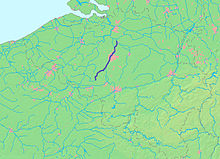Senne (river)
| Senne (French) Zenne (Dutch) | |
|---|---|
 The Senne inRebecq | |
 | |
| Location | |
| Country | Belgium |
| Physical characteristics | |
| Mouth | |
• coordinates | 51°03′54″N04°25′48″E/ 51.06500°N 4.43000°E |
| Length | 103 km (64 mi) |
| Basin features | |
| Progression | Dyle→Rupel→Scheldt→North Sea |
TheSenne(French:[sɛn]) orZenne(Dutch:[ˈzɛnə]) is a small river that flows throughBrussels,Belgium. Its source is in the village ofNaastnear the municipality ofSoignies.It is an indirecttributaryof theScheldt,through theDyleand theRupel.It joins the Dyle at Zennegat in Battel, north of the municipality ofMechelen,only a few hundred metres before the Dyle itself joins the Rupel.
In total, the Senne is 103 km (64 mi) long. TheWoluweand theMaalbeekare some of its tributaries.
Covering and treatment
[edit]

In Brussels, the Senne had become a serioushealth hazardby the second half of the 19th century, and from 1867 to 1871, under the tenure of thecity's then-mayor,Jules Anspach,its entire course through the urban area wascompletely covered over.This allowedurban renewaland the construction of modern buildings ofHaussmann-esquestyle along grandcentral boulevards,characteristic of downtown Brussels today.[1][2]The river is still visible in the outskirts of Brussels and outside the urban area, though within the city, it now runs mostly underneath theSmall Ring(Brussels' inner ring road).[3]
The Senne was notorious for being one of Belgium's worstpollutedrivers, despite work done to thesewersandspillwaysin theBrussels–Charleroi Canal,since alleffluentsfrom the Brussels-Capital Region emptied into it without treatment. The drainage into the canal was not able to completely stop the floods that regularly affected certain outer areas of the city.[4]In March 2007, the completion of newsewage treatmentplants began to remediate this problem.[5][6]However, in December 2009, the Brussels-North treatment plant of Aquiris was temporarily and abruptly shut down, creating a political andecological crisis.
Cultural impact
[edit]Theyellow irisbecame used as the emblem of the Brussels-Capital Region due to its habitat in the marshy plains around the river and a stylised version is featured on its official flag.[7]The unique seasonal wildyeastsof the Senne river valley are used in the production of the regionallambicstyle ofbeer.[8]TheBrasserie de la Senneis a recently opened brewery named for the river.[9]
Despite the covering of the Senne resulting in the river being all but invisible in central Brussels, it has had a cultural impact on the city. A nickname for residents of the city,zinneke,meaning "mutt" or "bastard" inBrusselian dialect,is taken from the stray dogs that hung around the streets by theLesser Senne(a tangent canal of the river) until the end of the 19th century. The name was revived at the start of the 21st century with the creation of theZinneke Parade,a multicultural biennial event in Brussels,[10]as well asHet Zinneke,sometimes calledZinneke Pis,abronzesculpture depicting an urinating dog.[11]
Gallery
[edit]-
North-eastern view from the bridge of theRue du Rupel/Rupelstraatin Brussels where the Senne leaves the city's canalisation
-
The Senne leaving the Brussels-North water treatment plant near Buda bridge inHaren
-
Remains of a sluice tower, quay and watermill over the Senne in the fields inWeerde
See also
[edit]References
[edit]Notes
[edit]- ^Demey 1990,p. 65.
- ^Map of Suys' proposal.City Archives of Brussels:p.p. 1.169
- ^Demey 1990,p. 85.
- ^Demey 1990,p. 84.
- ^"Brussels-North wastewater treatment plant".Aquiris.2007. Archived fromthe originalon 19 May 2007.Retrieved5 November2007.
- ^"Brussel eindelijk in orde met waterzuivering"(in Dutch). brusselnieuws.be. 2007. Archived fromthe originalon 17 November 2007.Retrieved5 November2007.
- ^"LOI – WET".www.ejustice.just.fgov.be(in French).Archivedfrom the original on 1 March 2021.Retrieved22 April2017.
- ^Jackson, Michael (September 1988).The new world guide to beer.Running Press.ISBN978-0-89471-649-2.Archivedfrom the original on 11 January 2023.Retrieved26 May2012.
- ^"Brasserie de la Senne".Brasserie de la Senne.Retrieved27 March2023.
- ^"Interview met Myriam Stoffen, directrice Zinneke"(in Dutch). 20 May 2008. Archived fromthe originalon 10 December 2017.Retrieved22 May2011.
- ^"Peeing statues".Retrieved15 June2018.
Bibliography
[edit]- Deligne, Chloé (2005).Bruxelles sortie des eaux: Les relations entre la ville et ses cours d'eau du Moyen Age à nos jours(in French). Brussels: Musées de la Ville de Bruxelles.ISBN978-2-9600373-1-9.
- Demey, Thierry (1990).Bruxelles, chronique d'une capitale en chantier(in French). Vol. I: Du voûtement de la Senne à la jonction Nord-Midi. Brussels: Paul Legrain/CFC.OCLC44643865.




